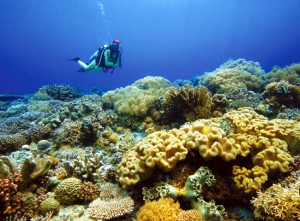PH center of ‘illegal’ live reef, aquarium fish trade

MARINE PARADISE LOST A diver fins through a field of pristine soft leather corals at the Tubbataha Reefs Natural Park. Unfortunately, only about 3 percent of the Philippine coral reefs are in “excellent condition.” YVETTE LEE / CONTRIBUTOR
CAIRNS—Foreign demand for food and ornamental fishes has made the Philippines the center of the unsustainable and often illegal live reef and aquarium fish trade worth at least $1 billion globally, scientists and experts said.
Michael Fabinyi, a researcher with Australia’s James Cook University who studied the live reef fish trade in Palawan province for several years, said increasing demand from China and Hong Kong had pushed people to harvest species like grouper and snappers, considered “luxury” food, using methods damaging to the health of the fishers and the marine environment.
Fabinyi, in his study of the live reef fish business in Balabac, Palawan, said the trade is an example of how the East Asian region is “consuming” the marine resources of Southeast Asia, which has to shoulder the long-term environmental and socioeconomic problems of the trade.
Global business
The live fish trade, which is driven by the consumption of the growing Chinese middle and upper classes, is a lucrative global business, valued at about $1 billion, according to Yvonne Sadovy, a marine science professor at the University of Hong Kong. About 150,000 metric tons of live reef fish are traded annually, she said.
Article continues after this advertisementThe scientists spoke in a forum at the 12th International Coral Research Symposium here.
Article continues after this advertisementExperts said China’s appetite for fresh fish has a devastating impact on the Philippines’ food situation and marine ecology.
Protected Areas and Wildlife Bureau Director Mundita Lim said the practice of Palawan fishers to catch juvenile snappers and groupers has led to the collapse of the live fish trade in the province.
“You should not get the juveniles from the wild. You should let them mature,” Lim said in an interview.
Fabinyi said China’s demand for these fishes, which are part of the dining culture and cuisine of the Chinese, is much greater than the demand from the Philippines.
Chinese restaurants in Manila, for instance, are not as well stocked with luxury food fishes as their Hong Kong or Chinese mainland counterparts, Fabinyi said.
Higher price
“The most obvious driver inducing people to get involved in the trade is the higher price of live fish, driven by increasing Chinese demand,” Fabinyi said in his 2012 study.
“From approximately 50 cents/kg in the late ’80s when the trade began, the price of leopard coral grouper has risen gradually and consistently, and in 2011, a good-sized leopard coral grouper in good condition fetches a price of between P700 and P1,000 ($16-23)/kg for fishermen,” he said.
In some places of the province, the price could shoot up to more than $60 per kilogram.
Fabinyi said local fishers are contacted by traders and middlemen, who finance their operation. The traders and middlemen, often based in cities like Manila, pay for their boats and fuel.
The live reef fishes are then transported to Manila, then Hong Kong, completing their journey in the Chinese mainland cities, where they are the main feature in social banquets and feasts.
‘Focal point’
Meanwhile, Elizabeth Wood, an expert from the Marine Conservation Society, said the Philippines is the “focal point” in the trade for aquarium fishes.
The latest data from 2005 showed that the Philippines exported 5.7 million aquarium fishes to the United States in that year, making the Philippines the world’s biggest supplier of aquarium fishes.
Indonesia trails behind the Philippines, and has become the number one source of aquarium corals after the former cracked down on coral trade last year, she said.
“Currently [there is] no evidence of any species collected for the marine ornamental trade being at risk of global extinction, but there is evidence of local depletions,” Wood said.
New problems
The trade on food and ornamental fishes is endangering the Philippines’ long-term food supply and is posing new socioeconomic problems for the country, experts said. “If overfishing continues, there will be [fewer] fish,” Sadovy said.
Sadovy said the highly valued live fish species, which are now in near-overfished state, were traditionally harvested in the West Philippine Sea (South China Sea). But the fish resources in this area are now depleted, she said.
Sadovy said napoleon fish, which is found in the waters of Indonesia and the Philippines and is known in the Philippines as mameng, is highly prized in China. The fish is now listed as an endangered species in the [International Union for Conservation of Nature], the only reef fish on the list.
Napoleon fish is priced at $150 a kilo, making it a lucrative catch for fishers and traders, Sadovy said.
While fishers who engage in live reef fishing get higher income, enabling them to access basic and economic services, they know that what they are doing is unsustainable, Fabinyi said.
Health concerns
There are also health concerns for local fishers.
Because many of them use cyanide to collect ornamental fishes and unfiltered air compressors, many of the fishers and divers end up with respiratory ailments.
“Moreover, diving for extended periods without proper decompression has led to paralysis—and in extreme cases, deaths,” Fabinyi said.